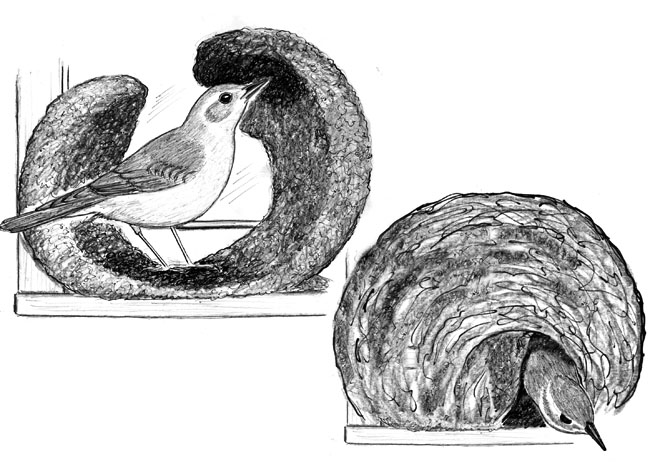
Dear Bird Folks,
Please identify the bird in the attached photos for me. I discovered them on the Internet but I can’t seem to find them in any of my bird books. The caption under the photos says, “Master builder,” but it never says the bird’s real name. Any idea?
– George, Dennis, MA
It’s the best, George,
Isn’t the Internet the best? I know some Luddites think computers will suck out our brains, but I think they are amazing devices. With one click you sent your mystery bird photos to me, and if you had wanted to you could have also sent the same photos to your friends all over the world (if you had friends all over the world). I’m glad you aren’t one of those paranoid freaks who think computers can control our minds. Although to be on the safe side, I never use my computer unless I’m wearing a helmet made out of aluminum foil. I may not be paranoid, but there is no sense in taking any chances. Plus, it’s a good look…I think.
The bird in your photos is a Rufous Hornero. I’ll bet you never heard of it, right? That’s because these birds are found in South America, which I believe is a long way from Dennis. A more English-sounding name for Rufous Hornero is Red Ovenbird, but even that doesn’t really help us form an image of what the bird looks like, so I’ll tell you. Despite the colorful name, Rufous Horneros aren’t all that colorful. The books say they are reddish/tan, but to me they look like brown mockingbirds. Surprisingly, Argentina has named the Rufous Hornero its national bird and I don’t get it. Argentina has all sorts of amazing birds, including penguins, rheas (tall flightless birds), parrots, hummingbirds and even flamingos. So why did the Argentines choose this brown bird to be its national bird? That’s a good question, but you can be sure Evita had nothing to do with it. She likely would have voted for something more glamorous, such as the “Glitter-bellied Emerald” or the “Gilded Sapphire” (yes, they are real birds). So why did they choose the Rufous Hornero? It probably has less to do with the bird’s looks and more to do with its nest-building skills. It seems horneros really are “master builders.”
Horneros (don’t ask me how to pronounce it) are typically found in open grasslands. Birds that live in such areas need to adapt their nests to fit their habitat. Meadowlarks, for example, hide their nests in dense grass. Killdeer don’t even bother with the grass; they lay their eggs on the bare ground, right out in the open. Natural camouflage is all the Killdeers’ eggs have for protection. Horneros aren’t about to lay their eggs on the ground. After all, they live in South America. Who knows what crazy things are walking around down there. For safety sake, these clever birds build huge mud nests high off the ground. It is this ability to construct these impressive adobe fortresses that make Rufous Horneros worthy of being Argentina’s national bird. But I still would have gone with the Glitter-bellied Emerald.
When searching for a place to build their nest, a pair of horneros isn’t very fussy. The top of a post, utility pole or an exposed tree branch is just fine for them. Both adults work nonstop to construct the dodgeball-sized nest. Sometimes the nest comes out perfectly round and other times it looks kind of lopsided, like a ball with a slow leak. When finished, the nest consists of two chambers. There’s a small entrance passage (perhaps the original “mudroom”) and a second section where the female lays her eggs. The thick mud walls protect the babies from predators, as well as insulating them from the summer sun. After about a month the little birds leave their adobe home and fly off with their parents. And even though the sun-hardened domes last for years, the original owners rarely use them again. But these marvelous structures don’t go to waste. The abandoned nests are eagerly claimed by small songbirds, finches and occasionally Jimmy Carter, who likes to secure them for Habitat for Humanity.
Horneros are fairly common birds and readily take advantage of the changes civilization has made to their environment. They flock to agricultural fields and parklands to search for crickets and other insects. They also like to build their nests on man-made structures. This is how the Rufous Hornero was brought to our attention. Opting not to build a nest on a tree branch or post, this particular pair decided to build their nest on someone’s windowsill. When the property owner discovered the birds’ construction project he/she wasn’t annoyed, but instead snapped a sequence of fourteen photos and posted them online. From these photos we are able to watch the different stages of nest building. The last photo shows us that the nest came out great, looking like a cross between a miniature Alamo and some high-end item from Pottery Barn.
Thanks for sharing your photos with me, George. It’s too bad horneros don’t live around here. It would be fun to witness their craftsmanship first-hand. For the folks who would like to see the pics George sent me, try doing a search for “Rufous Hornero nest construction” on the Web. With any luck you should find them, or something similar. Just keep in mind that when you use the Internet, be sure to wear an aluminum foil helmet on your head or your brain could get sucked out. So far it’s working for me…I think.